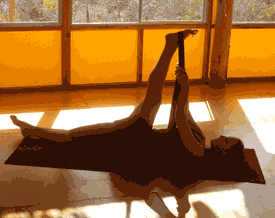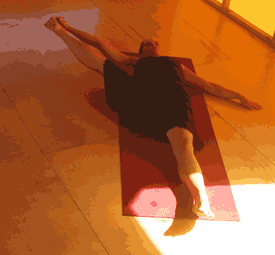 |
|
| Site Areas |
store | | | articles | | | forums | | | studios | | | vacations |
| yoga | massage | fitness | wellness | readings | ask the expert | |
Supta PadangusthasanaYogiSource.com Staff©Yoga People, LLC 2017 Pronunciation: SOOP-tuh POD-ung-goos-TAWS-uh-nuh Translation: The Sanskrit word Supta means reclining. The word pada translates to foot, and angusta means big toe. Asana means pose. This is the "Reclining Big-Toe Pose".
Introduction: The pose is a basic leg stretching pose. If you can do this pose well, then many more advanced poses will come more easily. The back of the leg is stretched in a way that isolates and works the hamstring deeply. At the same time, the pose helps the lower back and doesn't strain it. Those with tight hamstrings such as runners and bicyclists should learn and practice Supta Padangusthasana. Meditators who do lots of sitting can be helped by this posture as they may be prone to tightness in the buttocks, hips and lower back. You may want to practice the pose after doing Baddha Konasana, which opens up the hip joints. Supta Padangusthasana goes well as part of a forward bending series. Forward bends will also stretch your hamstrings. Do this pose first and go onto forward bends in your sequencing. See Utthita Hasta Padangusthasna which is a previous Yoga Article. It is a very similar pose in which you do the same leg actions from a standing rather than a supine position.
Technique: Lie on the floor on your back. You may put a prop such as a folded blanket or a block under your head for comfort and to avoid subsequent craning of the neck. Stretch both legs. Activate your quadriceps muscles (in the upper legs) to keep the kneecaps actively moving up the legs towards the pelvis. If possible, bring the extended left leg up so it as perpendicular to the floor. If the left leg does not yet come to 90 degrees, than bring it as high as possible. Do not allow the left leg knee to bend. Your right leg remains stretched and extended on the floor. When one raises the left leg, there is a tendency for the left side's hip bone to move up towards the ribcage. To correct this collapse between the hips and the ribcage, place the left hand on the upper left leg near the pelvis so the thumb is on top of the upper thigh and the fingers curl down on the outside of the leg. Now, use this hand to help while rolling the outer left leg down and the inner left leg up, bringing the left sit-bone closer to the right sit bone. Grasp the left big toe with the left hand. If you are unable to keep the leg straightened while grasping your big toe with your left hand then keep the left leg extended, place a strap over the ball of the left foot and grasp the strap as close to the foot as possible. Straighten and extend both legs, one in the air and one on the floor. Keep the toes of the right leg pointing straight up towards the sky. The feet should be flexed and the back legs extended from the bottom knee out through the heels. Your right leg should remain active throughout the pose. Keep the kneecap moving toward the pelvis and the toes pointing to the sky. Keep the buttocks on the floor. Resist the tendency for the raised leg buttock to come up. Throughout the pose keep moving the sit bone of the raised leg down towards the inner upper thigh of the leg on the floor. If necessary and somebody is available to help you place a strap around your upper thigh of the raised leg. Have the helper pull the thigh downward toward your feet while using the belt to rotate the upper thigh so the outer thigh descends as the inner thigh rotates upwards. That action brings the lifted hip side downward. Relax your abdominals. Your groin muscles should release to allow the lifting of the raised leg. You are at rest from the waist up your torso. Keep your spine elongated. Avoid the tendency to raise the chin and collapse the back neck. The use of a head support of the proper height will help stop the neck from craning in the pose. The hand that is not in use (side with the lowered leg) can rest on your thigh. Breathe normally for a few breaths in the pose.
Variation: This is a continuation of the pose. Grasp the inside of the left foot with your left hand. If the hand does not yet reach the foot than loop a strap around the foot and hold onto the strap with the left hand as close to the left foot as possible. On an exhalation lower your raised left leg down to or towards the floor aligned with the left shoulder. Keep the leg extended and avoid bending the knee throughout. As you descend the left leg roll the navel to the right and minimize the tendency to raise the right buttock and hip. Some people can bring the leg to the floor while others won't. Some will have the foot aligned with the shoulder while others will be aligned with a spot closer to the hips. Wherever you come now, continue to strive to assume the completed pose with extended legs and a flat pelvis. Maintain your toe hold or strap hold with your left hand. The Right leg should be maintained fully extended on the floor with the right toes pointing towards the sky throughout. Bring the left sit bone toward the right inner upper thigh once again. Imagine the weight of a sandbag on the right thigh once again or have a friend press it toward the floor. Breathe normally a few breaths in this variation. Keeping the extension of your left leg slowly raise it up again to point towards the ceiling. Release your foot and return to lying on your back. Do the pose on the other side with the opposite side lifted first in the air and then to the side. Benefits: The major effect of Supta Padangusthasana is stretching the hamstrings and hips. For many who suffer from Sciatica and from lower back pain This pose brings a welcome relief. If you have a flat lower back, doing the pose can help correct your postural alignment. The thighs, groins and calves get stretch as the knees strengthen. Those with paralysis of the legs can derive great benefit from this pose. Blood circulates in the legs and hips. Nerves are affected by the increased circulation. Relief is given for stiffness of the hip joints. The pose is said to prevent hernias. Knees are strengthened. The prostate gland is stimulated. Women experience relief from menstrual discomfort and are encouraged to do this pose with some long and supported forward bends. Supta Padangusthasana helps lower blood pressure. It may help in cases of infertility. The pose cultivates patience and the ability to stay in the present and experience what is happening. Cautions and Contraindications: Do not do this pose if you have a back injury or sensitivity in your lower back. Don't do the pose with carpal tunnel syndrome or sore wrists. Avoid the pose in pregnancy and don't do it when you have a headache. To modify the pose for high blood pressure, use a folded blanket under the head and neck. Thanks to Victor Oppenheimer for lending yoga expertise to the article and for editing it. All rights Reserved © Yoga People LLC |
| about us | contact | privacy | site map | careers | |

|
|

